Written by Jana Igunma
Henry Ginsburg Curator for Thai, Lao, and Cambodian Collections
London, British Library
The entire illustrated manuscript described in this article is available for viewing in Rollins College Archives Digital Collections: Siamese Manuscript of the Buddhist Funeral Folding Book
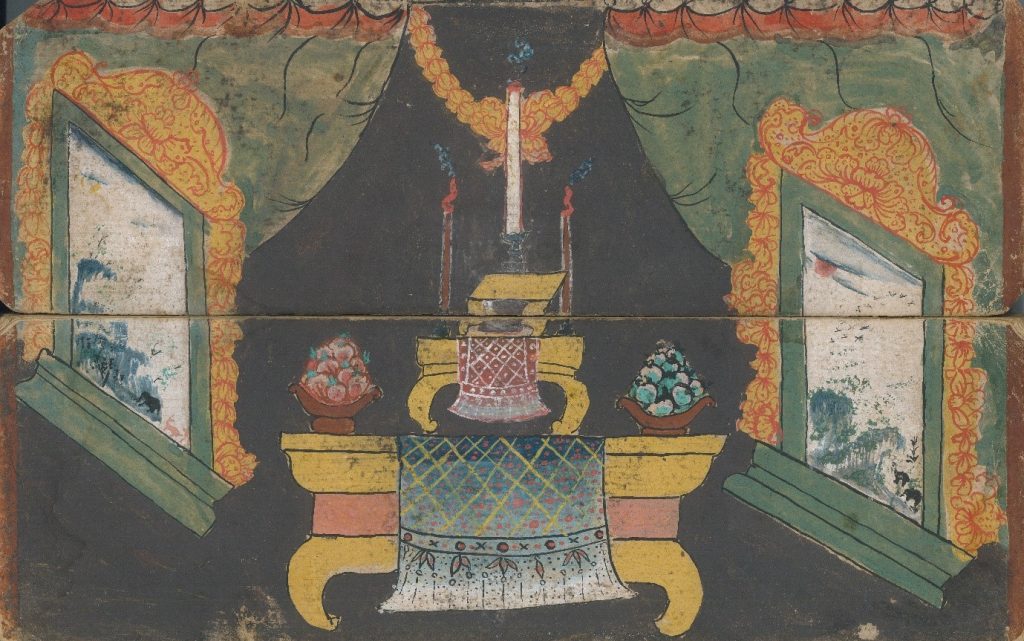
A still-life with European-style elements. Two stacked Chinese altar tables with Thai-style cloths, two bowls of fruit offerings, three candles, two table screens with decorated frames and painted panels depicting natural scenes with elephants and birds.
This rare manuscript from the collection of Henry Harkness is a folding book, or leporello book, which was made from naturally cream-colored mulberry bark paper in Thailand (formerly Siam). It contains a selection of extracts from the Buddhist canon Tipitaka, specifically from the corpus Abhidhamma-Pitaka. The texts were chosen for recitation at a funeral or commemoration service, and include excerpts from the Mātikā of Books 1–7 of the Abhidhamma, Sahassanaya, Uṇhissavijaya, Mahākassapabojjhaṅga, Mahāmoggallānabojjhaṅga, Mahācundabojjhaṅga,and Girimānanda-sutta.[1]
Most of the texts are in Pali language and were written with black ink in Khmer script, with added intonation marks in red ink on all folios on side A and some folios on side B. The purpose of the intonation marks was to guide monks to chant the text correctly. In Thai Buddhist culture, sacred Pali texts were often written down in Khmer script, but this practice was discontinued at the beginning of the 20th century. On folio B24 (side B), a colophon in Thai language written in Thai script reads “I, the writer of this Dhamma volume, wish to attain Nibbana swiftly. May the gift of the donor help to keep the religion pure/alive” (in Thai: ข้าพระเจ้าผู้เขียนพระธรรม์เล่มนี้ ขอไห้พบได้พระนิพพานเที่ด กับทารผู้ทรางไว้ในพระศาสนาณีเทีบ).
In addition to the text, the manuscript contains paintings on nine folios. They depict devatā (deities), Buddhist monks, hermits and withayathon (masters of magic), humans, plants and animals, a corpse, as well as one larger still-life of a Chinese altar covering a full folio. The latter depicts a Thai funeral volume in folding book format on top of two stacked altar tables with Thai-style cloths. There are also two bowls of fruit offerings, three candles, two table screens with decorated frames, as well as curtains and a flower garland. The illustrations are in the painting style of the Rattanakosin era, with some Chinese and European influences that became popular during the reigns of Rama III (1824-51) and Rama IV (1851-68). The manuscript does not contain a date, but it is estimated to have been created between 1824 to 1838.
[1] The author wishes to thank Dr. Trent Walker for identifying the Pali texts included in this manuscript.
Illustrations
Two deities (Pali: devatā) from God Indra’s heaven, Tavatimsa. They are sitting in a respectful pose (Thai: wai), facing a passage of Pali Buddhist text as an expression of their respect for the Buddha’s teachings. They are dressed in several layers of Thai-style loin cloths, jewelery and crowns. The Pali text in Khmer script in the middle section of the folio reads “Namo tassa bhagavato arahato sammāsambuddhassā” (English: I pay homage to the Blessed One, the Worthy One, the Fully Enlightened One). Above the text is a large bird of prey with an equally large moth or butterfly below. 1
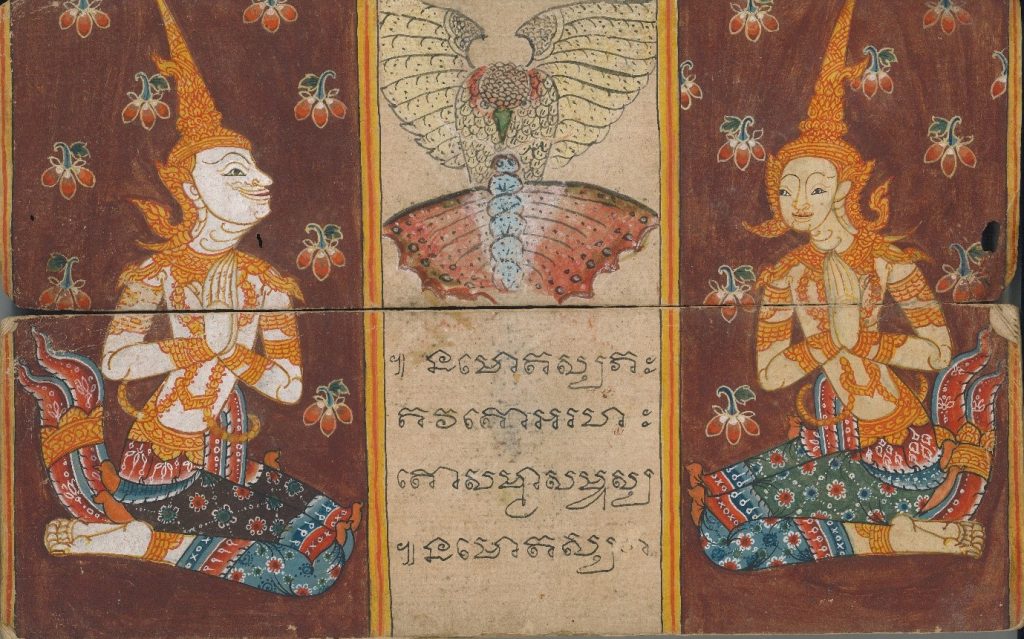
Two monks seated in a respectful pose (Thai: wai) wearing the typical, orange-colored robes of monastics in Thailand. They are facing a passage of Pali Buddhist text in the middle of the folio, expressing their respect for the Buddha’s teachings.
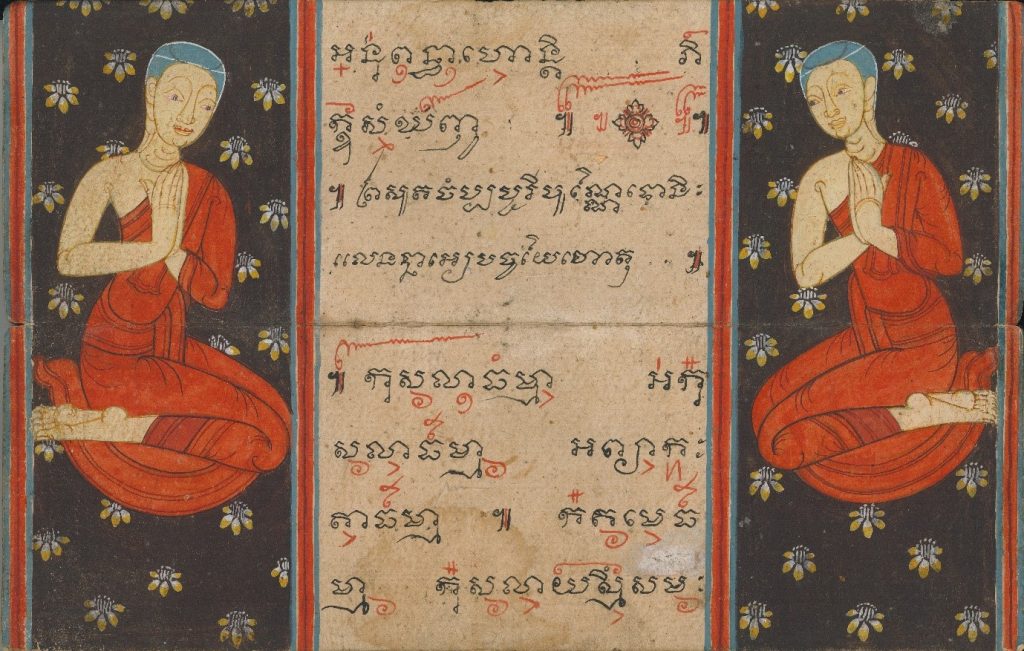
Withayathon means “masters of magic” in Thai but these figures are also called hermits. They are seated on rocks wearing the typical hermit outfit, a tiger skin designed robe and headgear; and one has a fan made from a Talipot palm leaf. The hermits face a passage of Pali Buddhist text written in black ink with intonation marks in red ink.
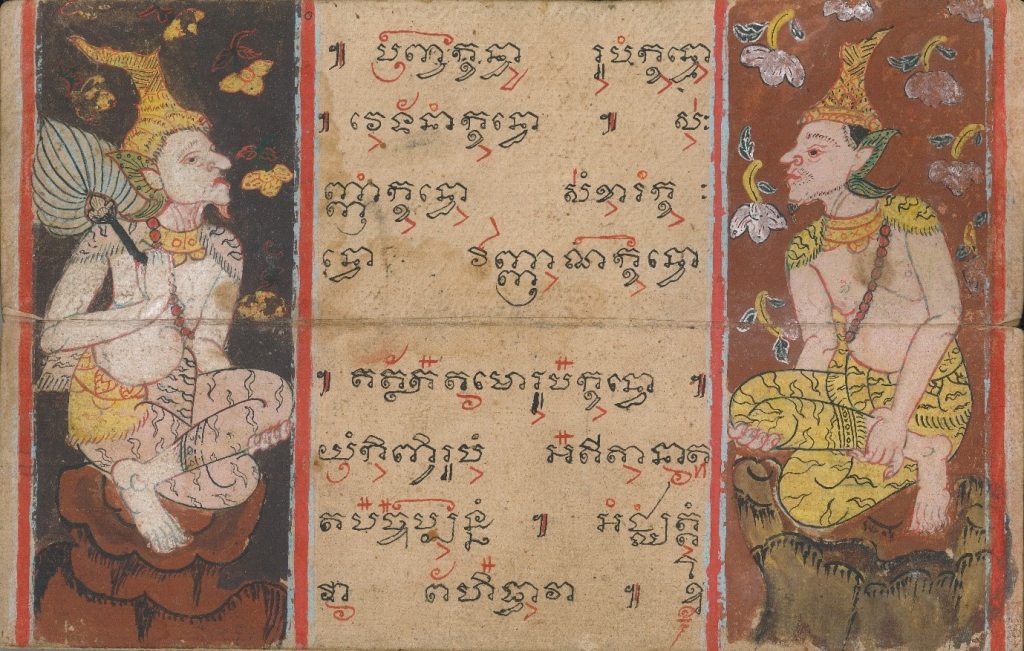
Two paired illustrations depicting stylized symmetrical plants with flowers. At the bottom, there are monkeys playing with rabbits. Nature scenes are often included in Thai funeral books, sometimes as a reference to the heavenly forest Himavanta, or for purely decorative reasons.
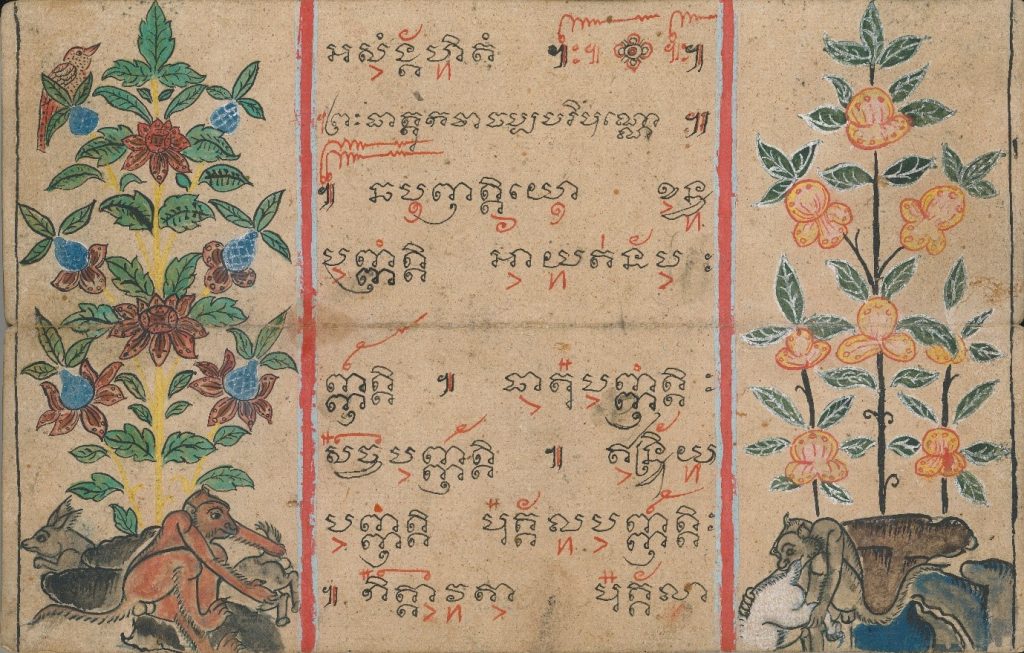
Two male figures representing humans, seated in a respectful pose (Thai: wai) and wearing multiple layers of Thai-style loin cloths and jewelry. They are facing a passage of Pali Buddhist text in the middle of the folio as an expression of their respect for the Buddha’s teachings.
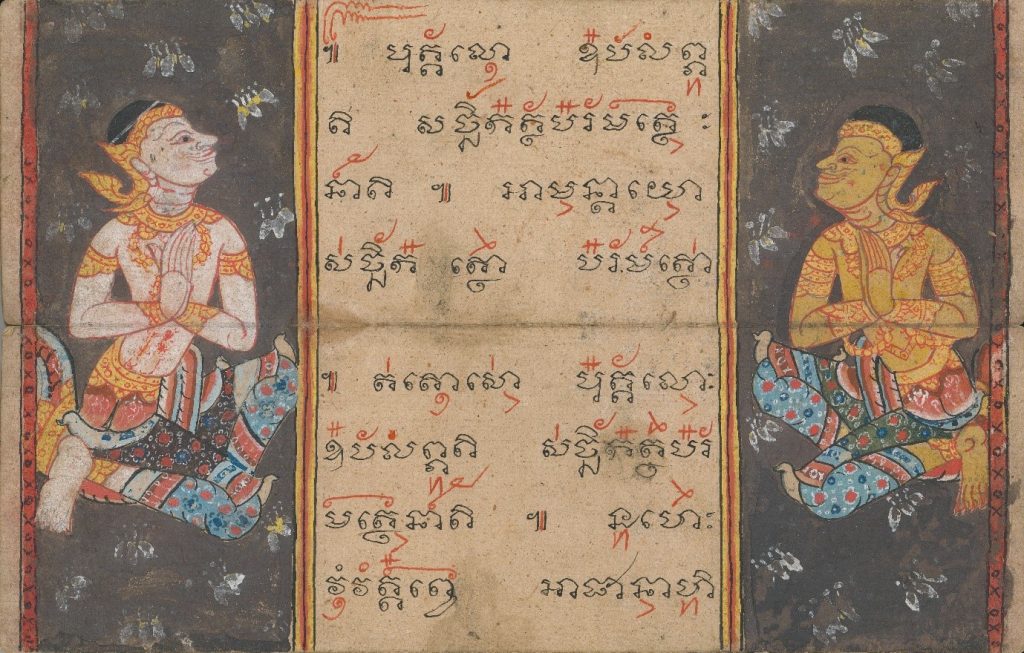
Two hermits or “masters of magic” (Thai: withayathon) wearing the typical outfits in tiger skin design, but only one on the left side is wearing a hermit’s headgear. The other on the right is touching his bald head with his right hand, as if he had a headache or an itchy scalp, while holding his headgear in the left hand. They are facing a passage of Pali Buddhist text written in the middle of the folio.2
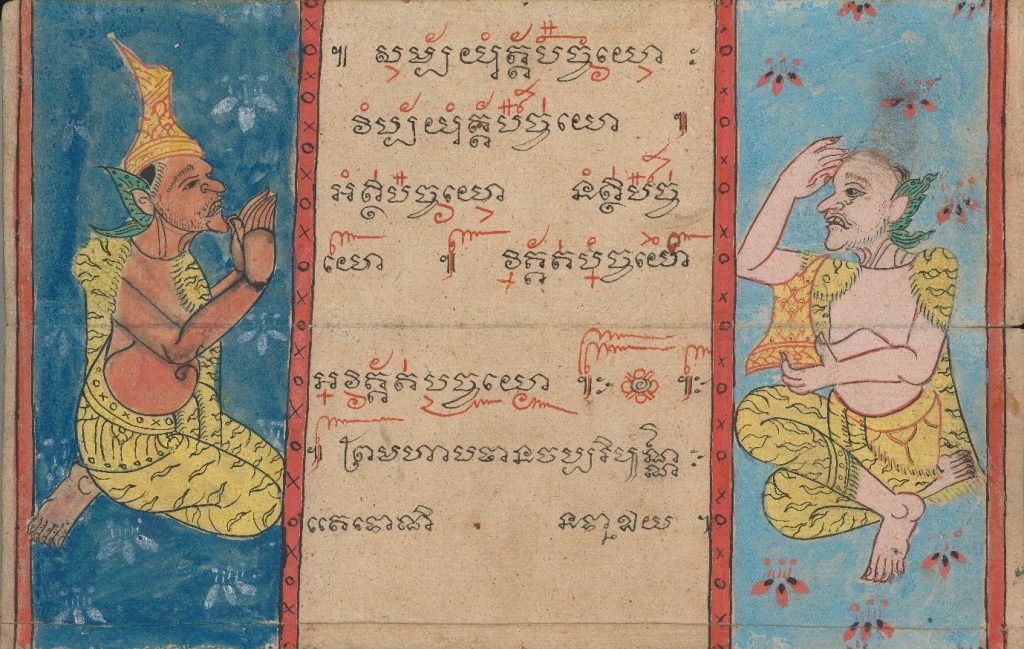
Two deities (Pali: devatā) from God Indra’s Tavatimsa heaven, seated in a respectful pose (Thai: wai). They are wearing several layers of Thai-style loin cloths, jewelery and crowns. Both deities are facing a passage of Pali Buddhist in the middle of the folio as an expression of their respect for the Buddha’s teachings.
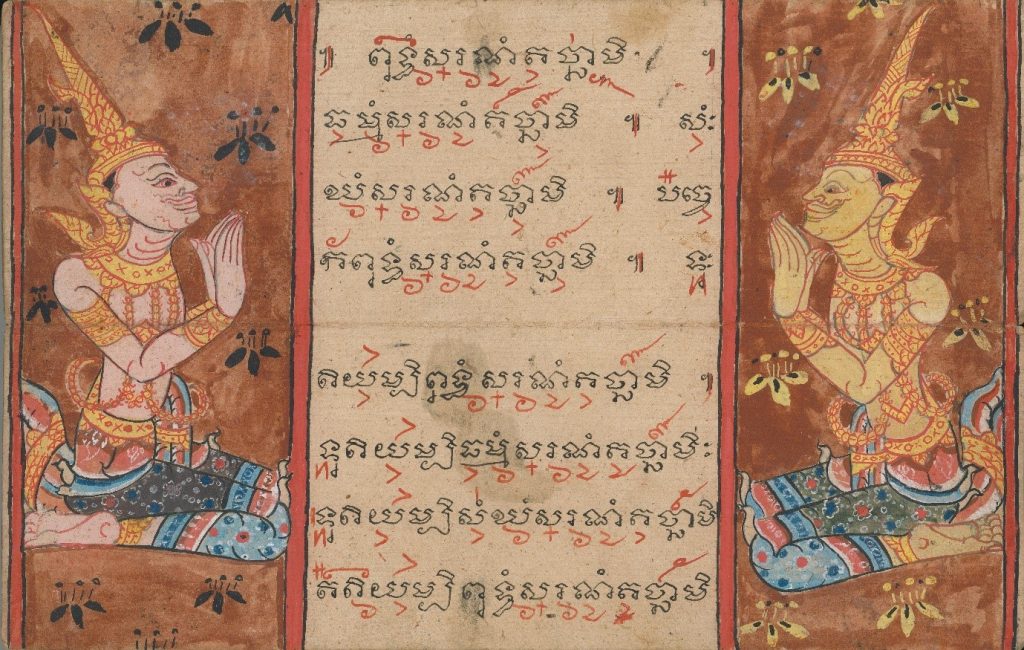
Illustration of an ordinary human figure with a simple loin cloth in horizontal position, most likely the corpse of a deceased person. Images of corpses are often included in Thai funeral books, but usually in connection with morbid meditations of monks who transfer merit to the deceased.
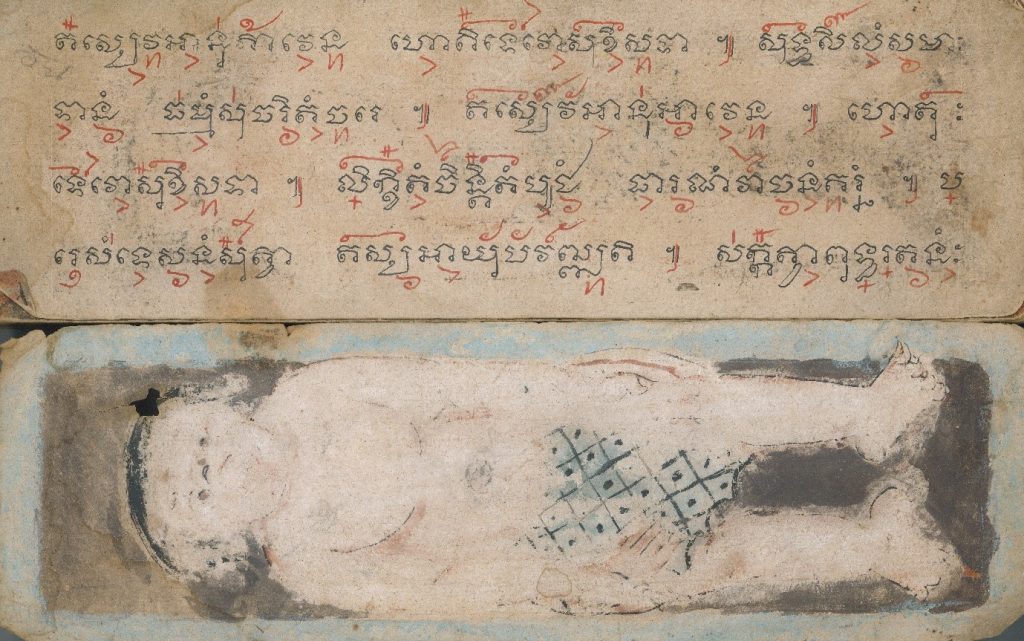
Image Footnotes:
- The bird and moth images are very unusual for Thai manuscript illustrations. It may be an influence from a non-Thai cultural context, or it could be an allegory on a Buddhist teaching like Karma. It could also be an unskilled attempt on painting Garuda, but this is unlikely. ↩︎
- Sometimes a humorous element is added to cheer up the grieving audiences s of funeral books. ↩︎
Further Reading
Igunma, Jana. Morbid Meditations in Thai Manuscript Art. British Library, Asian and African Studies Blog, 11 February 2014, https://blogs.bl.uk/asian-and-african/2014/02/morbid-meditations-in-thai-manuscript-art.html,
Igunma, Jana. Ten Birth Tales of the Buddha (IO Pali 207). British Library, Asian and African Studies Blog, 27 July 2015, https://blogs.bl.uk/asian-and-african/2015/07/ten-birth-tales-of-the-buddha-io-pali-207.html.
